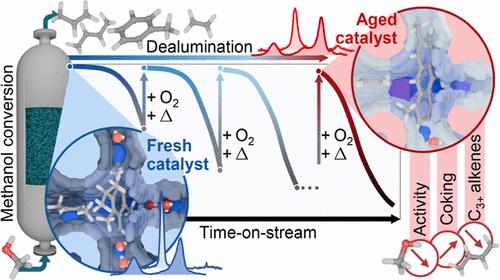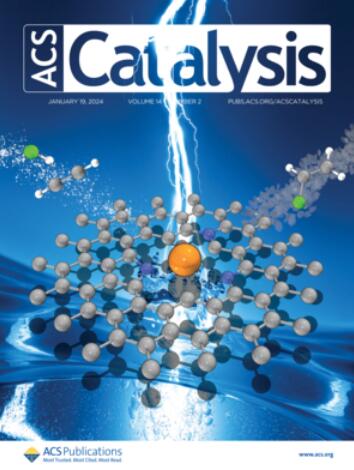甲醇制烃类转化过程中 ZSM-5 催化剂的结构变化
IF 11.3
1区 化学
Q1 CHEMISTRY, PHYSICAL
引用次数: 0
摘要
工业甲醇制烃类(MTH)转化工艺包括一系列在高温下进行的反应和再生阶段,并伴有蒸汽产生。尽管这些条件会导致催化剂结构的逐步降解,但其重组过程及其对 MTH 反应的影响仍然难以捉摸。本研究通过使用红外、27Al、29Si 和 1H 魔角旋转核磁共振以及操作扩散反射紫外可见光谱技术对老化催化剂进行深入表征,并辅以催化测试,系统地研究了 ZSM-5 催化剂在延长的 MTH 反应-再生运行期间的性能和结构变化。这些沸石的长期运行会导致框架铝的部分水解,这对沸石的孔隙率和结晶度影响不大,主要是导致布氏酸位点浓度下降。在最初的反应-再生循环中、在较高温度下以及在富含铝的 ZSM-5 沸石中,脱胶现象更为明显。控制蒸气和焦炭沉积实验表明,铝从框架位点脱落主要是由 MTH 反应过程中蒸发的副产品水造成的,尽管热应力和焦炭氧化也对这一过程有影响。在 MTH 反应过程中,烃类和焦炭的演化大大削弱了蒸汽的水解潜力。催化剂老化会导致出现扰动框架、框架相关铝位点和框架外铝位点,其中很大一部分会与剩余的框架位点相互作用。这导致在初始阶段产生路易斯酸位点,但其浓度会随着持续运行而下降。脱铝过程会降低催化剂的整体活性,增加氢转移和裂化反应的发生率。因此,这导致对 C3+ 烯烃的选择性降低,老化催化剂的结焦倾向增加。这些研究结果证明,沸石在 MTH 工艺中长期运行期间,其结构和性能具有很高的动态性,这一点应在该反应的催化剂开发和动力学研究中加以考虑。本文章由计算机程序翻译,如有差异,请以英文原文为准。

Structural Changes of ZSM-5 Catalysts during Methanol-to-Hydrocarbons Conversion Processes
Industrial methanol-to-hydrocarbons (MTH) conversion processes comprise a series of reaction and regeneration stages performed at elevated temperatures and accompanied by steam generation. Although these conditions contribute to the progressive degradation of the catalyst structure, the restructuring processes and their implications for the MTH reaction remain elusive. This study systematically investigates the performance and structural changes of ZSM-5 catalysts during extended MTH reaction–regeneration runs by complementing the catalytic tests with in-depth characterization of aged catalysts using infrared, 27Al, 29Si, and 1H magic angle spinning nuclear magnetic resonance, as well as operando diffuse-reflectance UV–visible spectroscopic techniques. Long-term operation of these zeolites leads to partial hydrolysis of the framework aluminum, which has a marginal impact on the zeolite porosity and crystallinity and leads primarily to a decrease in Brønsted acid site concentration. Dealumination is more pronounced during the initial reaction–regeneration cycles and at higher temperatures as well as in aluminum-rich ZSM-5 zeolites. Control steaming and coke-deposition experiments indicate that the dislodgment of aluminum from framework sites mainly arises from the byproduct water evolving during the MTH reaction, although thermal stress and coke oxidation also contribute to this process. The hydrolytic potential of steam is significantly attenuated by the evolution of hydrocarbon and coke species during the MTH reaction. Catalyst aging leads to the development of a perturbed framework, framework-associated and extraframework aluminum sites, a significant fraction of which interacts with the remaining framework sites. This causes the development of Lewis acid sites in the initial phase but their concentration declines with continued operation. Dealumination processes decrease the overall catalyst activity and increase the prevalence of hydrogen-transfer and cracking reactions. Consequently, this leads to lower selectivities toward C3+ alkenes and higher propensity to coking of the aged catalysts. The findings evidence the high structural and performance dynamicity of zeolites during their prolonged operation in the MTH process, which should be considered in catalyst development and kinetic studies of this reaction.
求助全文
通过发布文献求助,成功后即可免费获取论文全文。
去求助
来源期刊

ACS Catalysis
CHEMISTRY, PHYSICAL-
CiteScore
20.80
自引率
6.20%
发文量
1253
审稿时长
1.5 months
期刊介绍:
ACS Catalysis is an esteemed journal that publishes original research in the fields of heterogeneous catalysis, molecular catalysis, and biocatalysis. It offers broad coverage across diverse areas such as life sciences, organometallics and synthesis, photochemistry and electrochemistry, drug discovery and synthesis, materials science, environmental protection, polymer discovery and synthesis, and energy and fuels.
The scope of the journal is to showcase innovative work in various aspects of catalysis. This includes new reactions and novel synthetic approaches utilizing known catalysts, the discovery or modification of new catalysts, elucidation of catalytic mechanisms through cutting-edge investigations, practical enhancements of existing processes, as well as conceptual advances in the field. Contributions to ACS Catalysis can encompass both experimental and theoretical research focused on catalytic molecules, macromolecules, and materials that exhibit catalytic turnover.
 求助内容:
求助内容: 应助结果提醒方式:
应助结果提醒方式:


